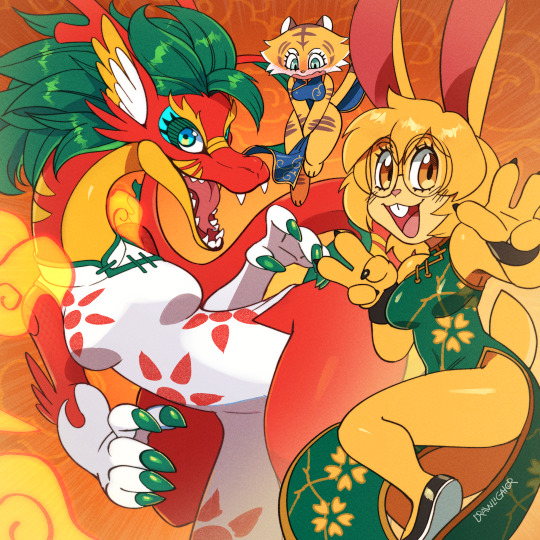Text
What if we look at eldrich knowledge and the ultimate reaction is just “stinky, gross :(” for no apparent reason? Rdtcfyvgubhinjomk,lkjhbgvfcvgsdahjkl
Being autistic is weird because I think I'd be entirely entirely immune to the maddening effects of witnessing an Elder God but learning that barnacles are arthropods rather than molluscs nearly gave me an existential crisis
16K notes
·
View notes
Text
i honestly forget that autism mums say 'autism won today' to mean like their kid had a meltdown and that they are ableist. like nooo autism win means something like i found something cool out about my special interest or i managed to avoid a meltdown or i got to infodump!!!!! autism win is good!!!!!!
34K notes
·
View notes
Text
Learned recently about why the pauli exclusion principle in quantum physics exists and how, and i don’t even know why, but it just filled me with a kind of disgust for some reason. It was interesting, it made sense, it works at describing the world, nothing weird happened in the discovery of the equations far as i know, but like
The reason any particles are solid is because the waves that make them crash into eachother and erases the likelihood of a wave existing there at all?? Idk it feels ick
Then my discomfort grew as i watched and saw that ah yes, not only that, but its the reason they repel or attract too, but that attraction/repulsion is not the reason why they cant exist in the same exact spot/pass through eachother. Nope, its that the likelihood of them being there drops to 0 when the ripples combine. Wtf. Then im left wondering how/why particles have a different ripple that COULD either coexist, cancel out, repel or attract etc which idk if thats ever been discovered or explained, and its like, weird/gross, gives me ick. But somehow that gives me less ick than just the reason why 2 solid particles cant exist in the same space. Bc there’s just a 0% likelihood of them being in that spot together. Ew/wth???
EDIT: here’s the video. Might be confusing, the background context is that objects are made of wiggles that exist a little bit everywhere at once, but a lot more in just this one spot so it looks like its somewhere. We describe them using math of “how likely are we to find them right here? Or how about here?” Or “how fast is it moving around rn?” (You have to choose. The location% and the speed% sorta fight eachother all the time, so you have to pick one if you want accuracy.)
I handled everything up to this point pretty well, i think? But this made me go “ew” and i litterally do not understand or know why, its an actual feeling of a kind of disgust.
youtube
Being autistic is weird because I think I'd be entirely entirely immune to the maddening effects of witnessing an Elder God but learning that barnacles are arthropods rather than molluscs nearly gave me an existential crisis
16K notes
·
View notes
Text
Fans' attitudes toward AI-generated works
Irina Cisternino, a PhD candidate of Stony Brooke University, is writing their research on topics related to technology, art and fandom. You can participate by filling out a survey and additionally, signing up for an interview. The survey is expected to last until at least the end of April, those, who signed up for the interview, will be contacted later. You need to be at least 18 years old to participate in either, be able to understand and speak English and identify as a fan.
After the completion of the research, it will be accessible as the dissertation of the researcher. If you have further questions, you can contact Irina Cisternino at [email protected] or Lu-Ann Kozlowsky at [email protected].
14K notes
·
View notes
Text
:c
vampires gotta drink blood to survive but prion disease is still a risk. their bodies and minds may be immortal, but not immutable. you encounter a vampire estimated to be fourteen hundred years old, and there's just...so little left of them.
they live in abandoned sheds, dusty attics, dilapidated sewer tunnels, anywhere that won't expose them directly to the sunlight. peering out from the shadows you can see the gaunt face filled with needle-like fangs, and those hollow, twitching eyes searching your features, trying to determine if you are Prey or Not Prey. the only thing they can still recognize. technically they're still alive, yes, but the person they once were died a slow, painful death trapped in that skull.
it takes your balance first, makes your gait unsteady and erratic. then comes the emotional instability, the sudden fits of laughter as common as the bursts of anger. then come the tremors, a constant uneven rumbling that you can feel even now as the ancient vampire rattles the floorboards in the other room. you've seen an old one hunt before. there's no grace to it, no deadly efficiency, it's a frantic, messy affair, all flailing, crawling limbs and gnashing teeth.
when you were turned, you were excited to live forever young and beautiful and sexy and mysterious but in this moment, staring at the withered hand slithering out from the darkness behind the cracked doorway, you remember why they call it a curse
533 notes
·
View notes
Text
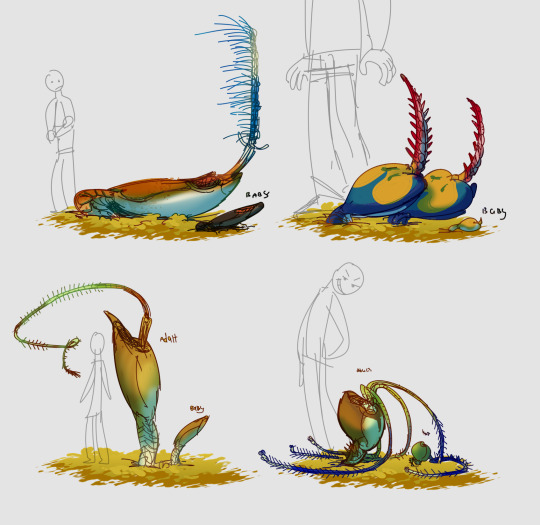
Slankats
Slankats are a wide group of Sinedenian parasitic heliophytes, most often found in areas with particularly thick foam grass layers which they parasitize on. It is the main host for the most slankats, although there are some exceptions.
This group of mixotrophs especially stands out from the rest, having a more animal-like appearance rather than the usual plant-like body plan. Some might confuse them with barnacles, due to their segmented tail and valved body with a feathery appendage.
They are highly specialized for parasitic lifestyle, to the point that some of them cannot produce their own nutrients by photosynthesis at all.
General anatomy of slankats
Their large bodies, despite their visual bulk, are actually very light and contain only a small number of tubular organs as well as a cavity for folding the stem into it. They attach to their hosts with the help of a scaly tail, at the end of which there is a spiked anchor with the bases of root organs on the sides. The roots of slankats are thin, long and highly branched, which allows them to absorb as many nutrients as possible from the foam grass.
At the top of the body there is a gill plate, with the help of which slankats breathe. Next to it there is a hole, from which emerges a flexible stem with genital organs growing on it (whip-flowers and chains of fruits).
The number of whips differs for different types of slankats (from 1 to 10). These whips carry female and male reproductive cells and unction similar to flowers on earth. When the whips are pollinated, after some time they wither away and in their place the fruits begin to grow, the number of which also varies. They can grow either in a chain or in a kind of bouquet.
Slancat fruits carry from two to ten embryos, and the fruit also contains chambers of gas that allow the fruit to fly away on wind currents or float on the surface of the water during floods (depending on the species, breeding cycle and season). When the fruit gets carried away to a fitting place, embryos emerge by popping out of the husk of the froot and then borrow into their host by using their tails.
167 notes
·
View notes
Text
Utik
The utik (yoo-tik) are a sophont species the rakii came in contact with when they first landed on Tkrin, their second largest moon orbiting Rek. The utik were actually the first to even set foot onto it, as they had no other choice. After suffering massive damage to their ship, the utik were forced to land on the lunar surface and hope to survive or await help.
Years later, the rakii show up, which started an a long, chaotic process of attempt of communication and debating ownership.


The bodies of the utik are actually not their true bodies. The actual sophont lies within the pearly cased cockpit. Utik like the Olac bio-mechs, mastered the technical art of bio-technology, having started on a very hot and humid planet. While unlike the Olac who switched to bio-technology as a means to evade a debilitating disease, the utik mastered it for years, working off various symbiotic organisms.
Their mech suits, or cyborg bodies you could say are symbiotic, as after their nervous and circulatory systems are linked, the pilot has full control of the suit, having it feed off waste material from the pilot. The suit then takes the waste, replenishes it, mixes it's own formula into it and feeds it back to the pilot. Like a plant, it gets a lot of energy off light and other forms of UV Retaining it for hours. These suits are suitable (ha) for open space, and lunar terran for a limited time. However proper measures are made to keep the suits tidy from "space dust" so no one goes out "naked" and risk exterior damage.
(quick sketch of utik 'pooters n screens. NOT ENTIRELY FINALIZED)
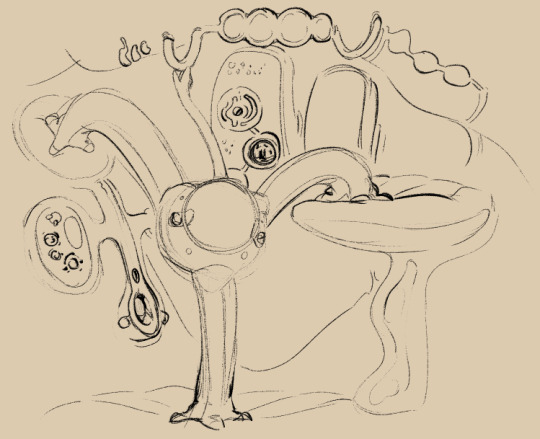
However, this isn't their true form. At least they didn't start off like this.
Way before, after they reached the ultimate feat in their development, their star was noticeably suffering, as it was predicted to eventually turn into black hole. While they had years 'till then, there wasn't enough time to perfect their original forms for the long-term space travel. So. as best they could, they learned to carefully strip and reduce themselves to nothing more than squishy muscle and brain matter, beforehand creating living space suits and sleeper pods to maintain what's left.
Several ships shot into space just in time before their star went dark and each ship jumped in different directions hoping to find and terraform a new world.
This group of utik weren't so lucky, as said before.
Now for the first half of the year, rakii and utik were on some tense terms. A lot of internal debates on who gets the moon. While utik were capable of defense, they weren't in a great position to, and the rakii weren't sure how to proceed with their first extraterrestrial contact. (Non-religious turned contact I'd guess???) UNTIL, one day it was brought ahead that, the utik secrete an anti-radiation slime. Something they came with naturally, just cranked to 10.

At first, the rakii thought to use this fluid as an applicable substance similar to sun-block, required to apply pre-spaceflight. However, it was revealed that they are extremely allergic to it. So skin-contact was a big no.
(Unfortunate rakii subject applying utik-based lotion. Results: swelling in skin, which can further cause blisters and splits)


After several trials, they came to a conclusion of using it as a gel layering in space suits, capable of absorbing radiation and protecting the wearer.
This discovery brought up a plan and a deal. It was agreed, rakii and utik would share the moon, making their first ever alliance, in exchange the utik would allow the rakii to harvest this anti-radiation goop off them, of course while exchanging knowledge, and resources.
453 notes
·
View notes
Text

Uniiman mount. They are present in almost every region either for travel or silk or both.
Something I forgot to add is their face plate rotates depending on how their body is angled. It's limited in movement but it gives the animal better spacial awareness. They have few eyes spots in their armor too but less sensitive.
More to their biology - while looking like a giant lobster they come from the same "fish" ancestors as Uniima. They belong to a group that kept their 3rd pair of limbs for locomotion, though these limbs are more specilised than the rest (in uniima the 3rd pair is part of their internal organs).
393 notes
·
View notes
Text

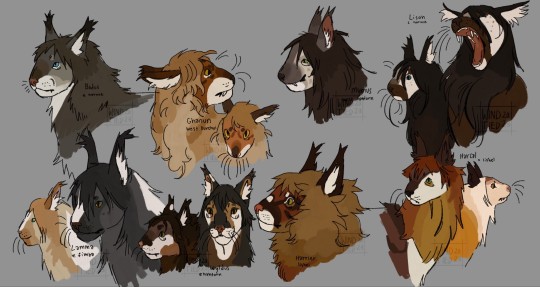
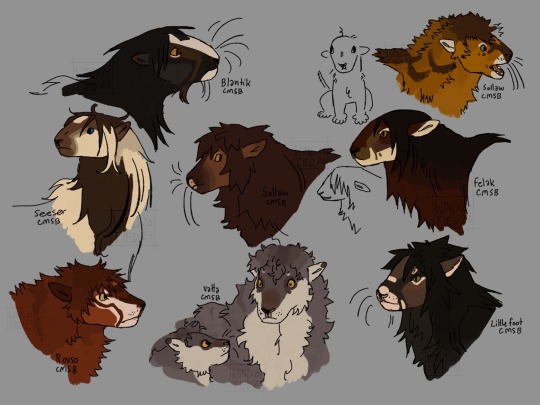


A bunch of recent world building. I've been doodling on regional differences, and revamping the anatomy of some species. Such as Fayons, Camsabi, and Loruz.
Group drawing is individuals of sophont species in eastern Hantorn. Comprised of a Meenki, a Fayon, two Werins, a Biehtim, a Loruz and a Minfil.
Other images consist of Meenki and Camsabi regional differences. Revisited design of Loruz (jackalopes) and doodles of Gorunes.
459 notes
·
View notes
Text
Love the ergonomic and really unique looking armor

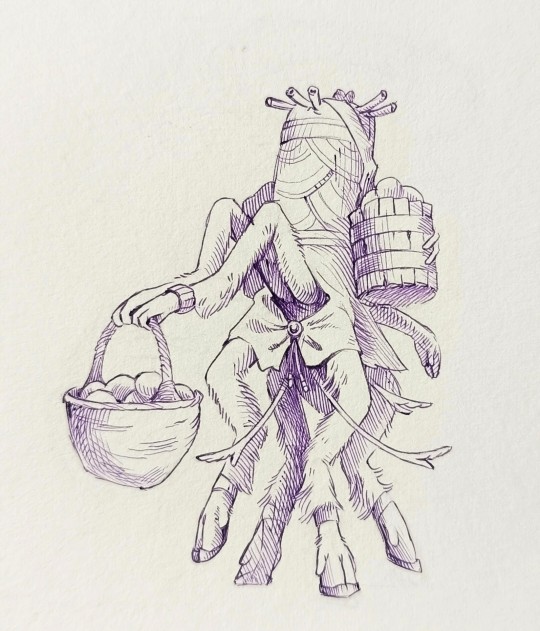

Thought it wouldn't be bad for horizontal animals to have more limbs, because more limbs = more things you can do with them, so beacons should get an upgrade too. Now they have 9 limbs – 5 hands and 4 legs, but that doesn't really change anything or contradict the leading hand thing, because they regard the double hand part as one hand or a "hand unit". Since these two hands are most of the time used simultaneously it doesn't really matter which one is the leading hand, but if none of them is, that's going to get noticed
Two eyes for each hand unit, 8 total. There's a 9th eye on the top of their head that acts as a third eye present in some animals of our planet
This also gives me an idea that beacons would often be too lazy to portrait all 9 eyes in their art, especially if they're portraying a horizontal animal, because we literally do the same thing. Not many people would draw a stylized fly with five eyes and a spider with the whole eight eyes set. As long as you can guess an animal from its silhouette shape and a few key features, no additional details are needed
I'm not very good at describing breathing and how sounds are made, but well here's an attempt of doing so. Hexapodal beacons have 3 lungs, each with some sort of a voice box. All voice boxes are equally developed, and only two of them are being used when speaking, while the third one is "resting", giving beacons the ability to chatter nonstop. It's the opposite in horizontal animals, whose upper lung does not have an exhaling nostril, and air just comes out of the inhaling one. Upper voice box is the most developed, and side voice boxes cannot produce any complex sounds, except probably low noises, but some animals cannot do even that. Now they have 4 lungs, but that's bot much of a change (for vertical animals, at least). Singing in four voices is certainly an art of its own, but any regular beacon is fine speaking with only two
514 notes
·
View notes
Photo
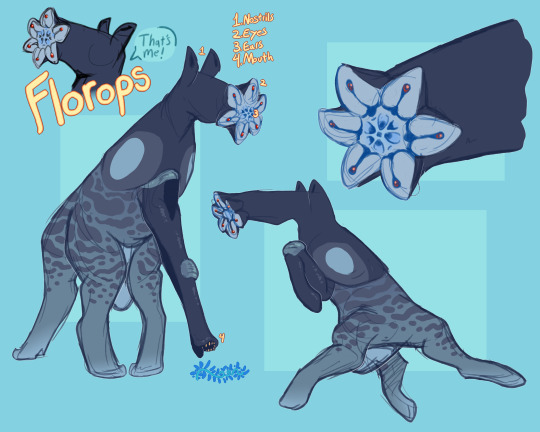
I RETURN! Wanted to try making like an actual alien, thinking of just making a bunch of dif designs for the funsies. Let the creative juice flow whilst I answer a big stack of asks!
This lil beastie is like a flower-faced grazing creature. Designing tripods is hard, they basically run on the front two while the back is for standing stability. Also I like to imagine that they use the ‘wrist’ of their proboscis to punch each other.
650 notes
·
View notes
Text
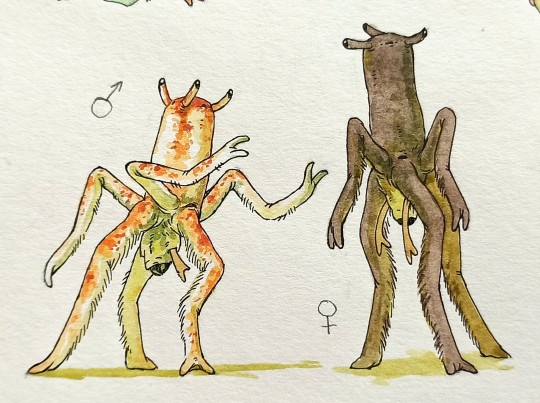
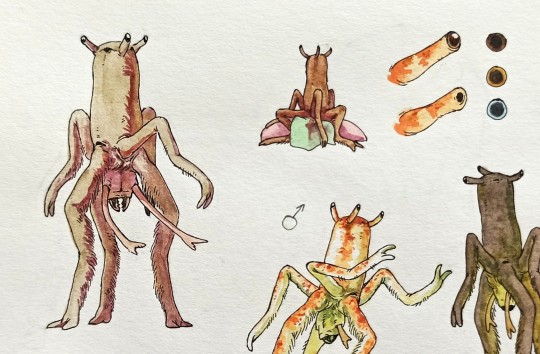
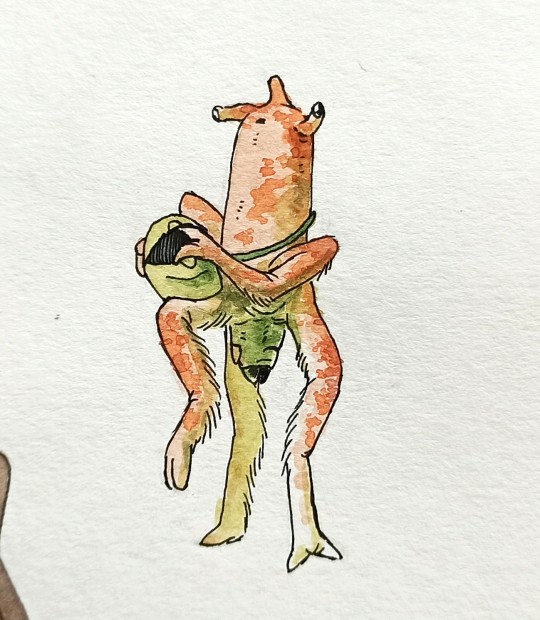
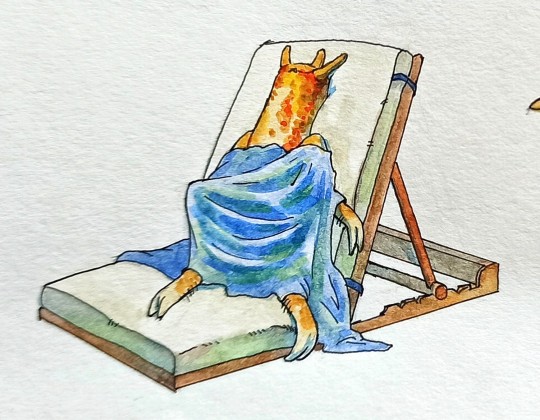
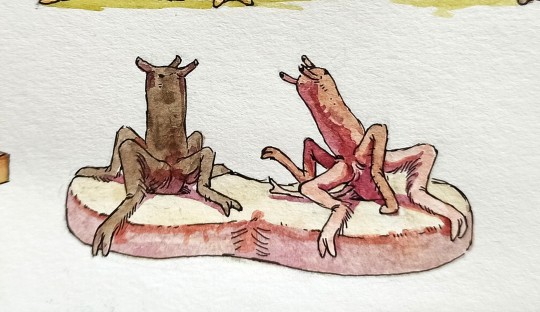
Some more stuff from my sketchbook
So on average males are shorter and brightly coloured while females tend to be greyish or brown. However, it's not uncommon to find a bright female or a dull coloured male
640 notes
·
View notes
Text
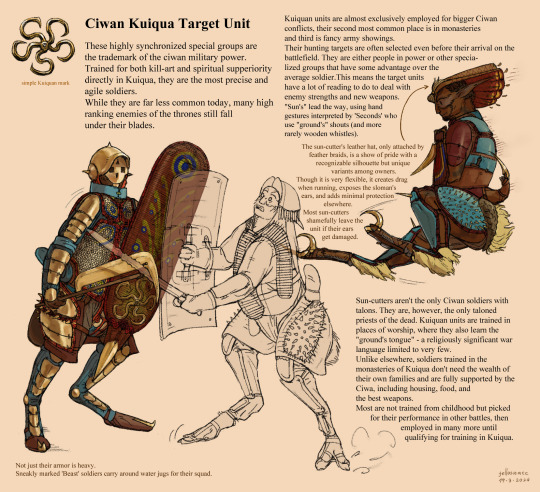

Welcome to a long one.
The Ciwan empire is the fastest-growing sloman power ever since the war of continents and the first to discover a form of gunpowder (thanks to their enemies being uniima lls who have been using it long before).
But even with that advantage (among slomen), the Ciwan armies are iconic for a different reason. That being the Kuiqua-trained units that Sun-cutters come from.
These units have traditionally existed for hundreds of years but are slowly just becoming a symbol for show because of the political and battling changes in the world. However, you will still see them from time to time ripping people to pieces.
Just like the majority of sloman military groups the unit relies on intense teamwork, they need constant communication and preplanned routes to deal with the opposing strategy.
The simplified average scene might look something like this:
In one unit of 30 members, three strikers (Sun-cutters) make a plan with their scholars and commanding Fire-catchers (Seconds leaders). After getting to the war zone they wait for their window in which some members spy or communicate with deeper army spies. When they know their target and best strategy they get in. The strikers use hand gestures, clicks, or whistles to save energy while the Seconds forward the orders to the rest with "ground's" (war language), wooden whistles see more use in very large units. Many times, however, often just seeing the movement of the sun-cutters is enough for the whole group to act.
Strikers will sometimes wait behind their heavies (Beasts) if their force isn't necessary (units can be as few as 5 members or as many as 50, the two extremes work very differently). Once the situation calls for it, they bullet their targets, often stabbing talons first and tearing muscles in a swift motion. This may happen multiple times as other unit members engage in direct battle with the target/s or disarm them with specialized tools. Kuiqua units both kill and capture, having healing supplies on their heavies if they need to make sure their target doesn't bleed out (or their own soldiers).
All members of the Kuiquan unit are priests of different levels but all are priests of the dead (ones that speak for their ancestors rather than gods). It's believed lands conquered with these soldiers present will flourish with life. Many former battlegrounds have turned into gardens and crop fields (hopefully they don't keep this up when landmines are invented).
To the image. What you see is a small variety of soldiers. Beasts and fire-catchers have other names and features in their armor that they are known for based on all their roles that can often switch between fights. Only Sun-cutters truly have one name.
Fire-catchers are also sometimes strikers in training and may move up if they prove themselves. Though, more often Sun-cutters rise from the ranks of regular taloned soldiers with enough talent.
-
As mentioned in the image, Sun-cutters tend to be very prideful. Their helmets are an impractical mess that pushes their ears forward. A Ciwan Sloman's ears are very important to them and if they are damaged it's a career-ending event. Still, almost no strikers bind their ears, not wanting to be shamed for cowardness.
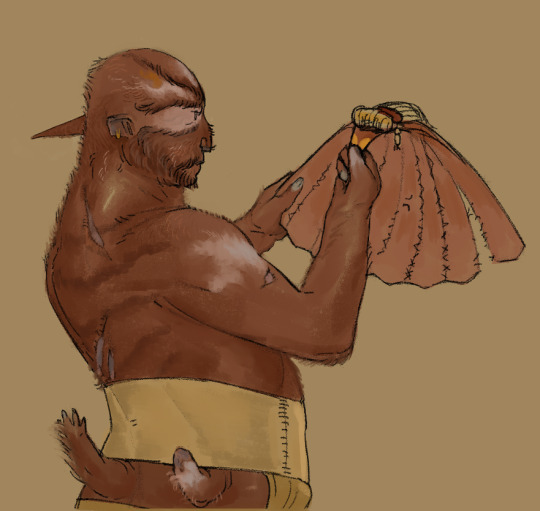
an ex-striker
here is the whole picture if you prefer it big

Btw, Kuiqua is the city Neal lives in. He has met or been arranged to meet these units multiple times since Neal himself is stuck classified as a fancy soldier. They are also not uncommon around temples, small talk is required.
Thank you for reading this far! Next I must answer the questions of biology. This has taken me 50 000 years.
508 notes
·
View notes
Text

NEW ALIEN LETS GOOO.
This time these are fellas living within the iron clouds of a gas giant.

They're quite large, think building sized, and spend most of their time floating through the cloud layers feasting upon the microscopic critters in the air around them. They catch their food in the fronds of their feeding arms before passing them through their looong mouth. I don't know if this is plausible but I think I'm going to cut their planet into two main sections, a super heated sky of gaseous metals and then a small compact core. Wanted them to be in a position to breathe iron instead of oxygen, if they came into contact with our atmosphere they would rust from the inside out. But on their planet they are happily bobbing around in the sky as if weightless. It just works.
These fellas are gunna be in the same universe as my pentapods, I think the theme is going to be 'planet bound societies interacting via space junk left over from another fallen civilization'. So whereas pentapods are planetlocked because of having no access to actual ground materials, these fellas are more so bound by the extremes of their habitat.
739 notes
·
View notes

